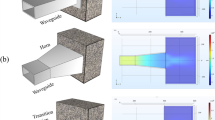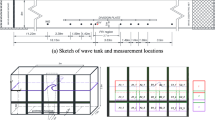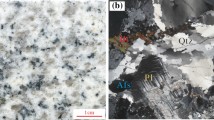Conclusions
-
1.
The interaction of uhf electromagnetic waves with dielectric rocks can lead to selffocusing of the waves within the rock, causing the development of internal heat sources which have a disruptive effect on the rock.
-
2.
A decrease in the wavelength of the electromagnetic radiation leads to a reduction in the critical dimensions of the internal heat sources necessary for the production of breaking deformations. A rise in the power of the uhf radiation reduces the time taken for the development of the internal heat sources.
-
3.
Further investigations will enable us to elucidate the influence of the composition and structure of the rock on the course of self-focusing, and also the possibility of obtaining controlled self-focusing. Of special interest is the study of the mechanism of formation of plasma, which absorbs the electromagnetic radiation, in the zones of self-focusing.
Similar content being viewed by others
Literature Cited
L. É. Rikenglaz. “Theory of heating of dielectrics by powerful electromagnetic fields,” Inzh.-Fiz. Zh.,27, No. 6 (1974).
V. V. Rzhevskii and Yu. I. Protasov, Electrical Rock Breaking [in Russian], Nedra, Moscow (1972).
A. N. Moskalev, O. V. Yavtushenko, and V. I. Loik, “Experimental investigation of the temperature fields in dielectric rocks subjected to uhf action,” in: Abstracts of Third All-Union Conference on Thermomechanical Methods of Rock Breaking, Kiev (1976).
G. A. Askar’yan, “Action of the gradient of a field of an intense electromagnetic beam on electrons and atoms,” Zh. Eksp. Teor. Fiz.,42, No. 6 (1962).
V. I. Talanov, “On self-focusing of electromagnetic waves in nonlinear media,” Izv. Vyssh. Uchebn. Zaved., Radiofiz.,7, No. 3 (1964).
N. F. Pilipetskii and A. R. Rustamov, “Observation of self-focusing of light in liquids,” Zh. Eksp. Teor. Fiz.,2, 18 (1965).
Yu. I. Kyzylasov, V. S. Starunov, and I. L. Fabelinskii, “Forced Mandel’shtam-Brillouin spacing and fracture of glasses in a giant pulse from a ruby laser,” Fiz. Tverd. Tela,12, No. 1 (1970).
V. I. Bespalov, A. G. Litvak, and V. I. Talanov, “Self-action of electromagnetic waves in cubic isotropic media,” in: Nonlinear Optics [in Russian], Nauka, Novosibirsk (1968).
V. N. Pugovoi and A. M. Prokhorov, “The theory of propagation of powerful laser radiation in a nonlinear medium,” Usp. Fiz. Nauk,3, No. 2 (1973).
G. A. Askar’yan, “The self-focusing effect,” Usp. Fiz. Nauk,3, No. 2 (1973).
Handbook of Physical Constants of Rocks [Russian translation], Mir, Moscow (1969).
G. A. Askar’yan and V. A. Pogosyan, “Thermal trace and self-focusing of a powerful beam in a medium,” Zh. Eksp. Teor. Fiz.,60, No. 4 (1971).
Author information
Authors and Affiliations
Additional information
Translated from Fiziko-Tekhnicheskie Problemy Razrabotki Poleznykh Iskopaemykh, No. 3, pp. 46–52, May–June, 1978.
Rights and permissions
About this article
Cite this article
Moskalev, A.N., Yavtushenko, O.V., Loik, V.I. et al. Feasibility of using self-focusing of uhf electromagnetic waves in breaking dielectric rocks. Soviet Mining Science 14, 274–278 (1978). https://doi.org/10.1007/BF02499325
Received:
Published:
Issue Date:
DOI: https://doi.org/10.1007/BF02499325




